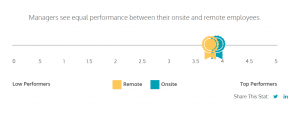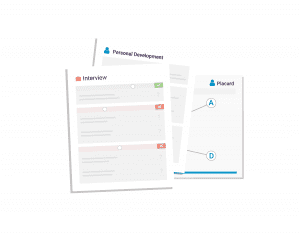Your Team Can Work from Home, You Just Have to Understand Them
By Thomas MacIntosh |
4.5 min read
Your Team Can Work from Home, You Just Have to Understand Them
The Emprical Data
You probably know this to be true, without even seeing data. When we work from home, we are more productive, have time in the morning to workout or meditate, and are generally happier with our working situation.
Empirically, the idea makes sense. By working from home, you save time, can focus in a quiet space, all while producing the same output thanks to the good old internet. Saving the time to the office alone gives the idea some backing. If your commute is forty-five minutes each way, you could add an extra hour and a half of time to your day. In the business world, and hour and a half is almost priceless.
The Normative Data
The data backs up the idea as well.
Stanford University professor Nicholas Bloom studied 500 employees working for CTrip, a company with over 16, 000 employees. Comparing a control group that worked in the office, and a group that worked at home, Bloom found that productivity at home increased equivalent to an entire day’s work. [1]
OwlLabs 2017 Report on Remote Work gauged employees’ level of investment in their work based on their work status. They found a negligible difference in investment regardless of how often the person works remotely. [2] This isn’t just coming from the employees. A study of 1,097 US-Based respondents across all company sizes and industries rated remote and onsite workers’ performance almost identically. [3]

From OwlLabs 2017 “State of Remote Work 2017”
The benefits an employee receives from being able to work remotely spill over to the company as well. That same Stanford University study found that employee turnover at the company decreased by 50%, sick days used decreased, and people took less time off. [4] The policy of allowing remote work also helps attract Millennial talent, with 68% in one study saying that would make them more likely to want to work for a company. [5]
There are plenty more studies that all make the same recommendations: if you can swing it, let your employees work from home.
Now obviously there are companies who can’t do this. Imagine an elementary school teacher skype-ing into her grade three class? There may be some issues there.
However, for most office-related jobs, the chance for remote work is there. By bringing home your work laptop and phone, you can essentially set up the same desk as you would have at work, just in a different area.
How can you accommodate remote work?
So, should you immediately sell your office and move everyone into their homes? No. There are still some issues that can arise from remote work. These are some that OwlLabs discovered in their 2017 report [6], and ways to combat them:
- Employees can feel isolated from the lack of contact. Being alone all day can create a sense of being, “alone.” To combat this, encourage face-to-face conversations with technology like Zoom Meeting.
- Creating a company culture. With everyone talking remotely, it can be tough to mold a corporate culture. Instead of thinking about your company culture as what happens inside the walls of the office, start to incorporate the idea of remote workers as part of the company culture. Start a slack channel where employees can post pictures of the cool places they are working from. Boast about your remote worker’s success online. Provide incentives like funds for gym passes to encourage workers to use the time they save not commuting to workout.
- Tracking productivity. Productivity alone can be difficult to track at an organization, whether employees are in the office. Much the same as you would with everyone between the same walls, set daily key performance indicators that are backed up by long-term smart goals. Use a company like Asana or Notion to establish a Kanban board so you can track the progression of projects.
Managing a team remotely can be tough for a manager as well. How do you know what each individual needs in order to be most productive when you can’t get a sense of who they are over months spent in the office?
How can you be an effective remote manager?
The Predictive Index Behavioural Assessment allows you gain an understanding of someone’s drives, strengths, and weaknesses, while also providing complete Manager Guides that are full of detailed, actionable and personalized management strategies for each individual. The best part? The Predictive Index software can be accessed from anywhere.

The Predictive Index provides a variety of personalized resources for managers and employees to use.
Want to learn more about The Predictive Index, and see how you can use it to institute a remote team? Contact Thomas MacIntosh at tmacintosh@predictivesuccess.com or call 905-430-9788 x 104.
Sources:
[1] Bloom, Nicholas, James Liang, John Roberts, and Zhichun Jenny Ying. “Does Working from Home Work? Evidence from a Chinese Experiment.” 2013. doi:10.3386/w18871. [2] “State of Remote Work 2017.” Owl Labs. Accessed July 24, 2019. https://www.owllabs.com/state-of-remote-work-2017. [3] ibid. [4] Bloom, Nicholas, James Liang, John Roberts, and Zhichun Jenny Ying. “Does Working from Home Work? Evidence from a Chinese Experiment.” 2013. doi:10.3386/w18871. [5] “11 Surprising Working From Home Statistics.” Fundera. Accessed July 24, 2019. https://www.fundera.com/resources/working-from-home-statistics. [6] “State of Remote Work 2017.” Owl Labs. Accessed July 24, 2019. https://www.owllabs.com/state-of-remote-work-2017.Related Blogs
Employee Retention Programs: Keeping Your Best Talent Happy
Employee retention is a cornerstone of business success. High turnover rates can be detrimental, leading to increased recruitment costs, loss of organizational knowledge, and decreased morale. At Predictive Success, we understand that retaining top talent
Are You Equipped with the Right Salesperson?
Introduction: In today's competitive market, many variables are beyond your control. However, one crucial factor you can manage is assembling the right sales team to drive your business forward. Having the optimal sales team is
Mastering Pre-Employment Testing to Find the Perfect Fit
Hiring the right talent is critical to the success of any organization. A single mis-hire can result in significant costs, including wasted time, lost productivity, and the expense of rehiring and retraining. Pre-employment testing has


